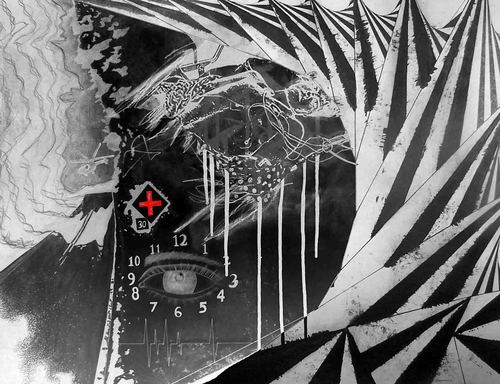
Brian Boyle, Time is of the Essence, 2006, graphic pen and charcoal on paper, 24 x 36in., (artwork © Brian Boyle)
Every artist has a focus and a story to tell. My name is Brian Boyle, and this is my story.
My life changed drastically on July 6, 2004. One month after I graduated high school, I was coming home from swim practice and was involved in a very serious car accident with a speeding dump truck. The impact of the crash knocked my heart across my chest, breaking most of my ribs, clavicle, pelvis, collapsing my lungs, bloodloss of 60 percent damaging every major organ in my body, causing severe nerve damage to my left shoulder and left me in a coma where I was on life support for over two months at Prince Georges Hospital Center in Cheverly, MD.
In the blink of an eye I went from being a high-school graduate to a practically lifeless body on my deathbed. As for the future, it did not exist. My life was ripped away in an instant, and all that I had left as a reminder was a broken body covered in scarred flesh and a fragmented memory of what happened.
My rehabilitation and therapy was not just physical, it was also psychological and emotional. It was therapeutic for me to put my thoughts on paper, through writing, drawing and also through photography. For many hours of every day, my pen was my psychiatrist and I spoke through it subconsciously, and my emotions poured out onto the paper and into the computer.
I did not have an actual memory of the accident taking place, but I remembered most phases of the coma, and after a few weeks of getting strong enough to write and draw skillfully again, I explored my tragic past in order to confront and understand what happened to me.
The intense concentration that took place while visualizing and illustrating the subject matter helped me focus into the subconscious memories that lay beneath the surface of my mind. Having the ability to put my thoughts and memories down on paper was very therapeutic because it was the most efficient form of self-expression, which allowed me to embark on an internal journey in search of understanding.
Art portrays who I am as a human being and shows my inner feelings that cannot be expressed by words; recreating scenes from my memory of being in a coma, hallucinations, never-ending operations and the often hopeless atmosphere. To illustrate these scenes, I often use symbolic colors and images, disorienting compositions of blurred first-person perspectives and other methods that will recreate the memories.
This is what makes art so extraordinary, because an image that appears to be a blotch of colors is actually an expression of the artist’s emotions. I can create a different interpretation of my work, just by adding a variety of color-coordinated textures and value changes. An artist portrays their thoughts and feelings into their work by using neutral colors like gray and blue to show a feeling of peace, or use more vivid colors like red and orange to show rage or anger, and most importantly the essence of life, the substance of blood. The usage of black and white colors shows a clear boundary of life and death.
I try to use different effects like this in my artwork to catch the viewer’s eye; elongating a certain stroke or angle can change the whole perspective of a painting or sketch. Whether I’m drawing a picture of the intersection that my accident took place, or trying to recreate the feeling of being comatose, the art that I create attempts to put these fragments of my agonizing past together again.

Brian Boyle, Comatose, 2010, film, 2:00 (artwork © Brian Boyle)
Click here to view short film, “Comatose”.
I strongly believe that life is a learning experience in itself because every day you discover a new element that makes you stronger as an individual. Art is symbolically similar to life because art represents the essence and nature of life, which makes art as well as life a learning experience.
When I begin a new project, whether it’s digital, print or audio, I usually do not have a starting place or final product in mind. I just start drawing and it leads to a subconscious exploration of the haunting and fascinating visions of my past.
After the first mark on the paper is put down, I am flooded with memories that are visual representations of my subconscious. My method of reaction will vary, but my hope is to confront these images on a visible scale in order to make sense of them and from doing this these past few years, I finally have the closure that I have been seeking.
My journey back to life has been a very slow and often difficult process, and my art has also been a journey in itself to understand and confront this process.
You must be logged in to post a comment.